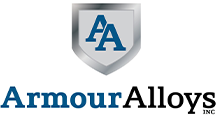
We collect basic website visitor information on this website and store it in cookies. We also utilize Google Analytics to track page view information to assist us in improving our website.
301 Stainless Steel is a modification of 304 stainless. When cold worked, it provides a high strength and ductility for a variety of applications. This material is available in a variety of tempers including 1/4 hard, 1/2 hard, and full hard depending on end use. Common applications for this material include auto body trim, utensils, aircraft parts, and architectural products.
Chemical Composition
| Element | 301 |
| Carbon | 0.15 Max |
| Manganese | 2.00 Max |
| Sulfur | 0.030 Max |
| Phosphorus | 0.045 Max |
| Silicon | 0.75 Max |
| Chromium | 16.0-18.0 |
| Nickel | 6.0-8.0 |
| Nitrogen | 0.10 Max |
Mechanical Properties
| Tensile Strength | Yield Strength | Elongaton (2") | Rockwell Hardness |
| 110,000 | 45,000 | 55% | 85 |
| Stainless | |
| Armour Alloys | |
| Sheet, Plate, Coil | |
| Springs, Structural parts, Trailer Bodies, Diaphragms, Utensils, Architectural and Automotive trim, Hose clamps, Wheel covers, Roofing products, Kitchen utensils | |
| Type 301 exhibits corrosion resistance comparable to Types 302 and 304 in the mild service conditions. Resistance to atmospheric corrosion, food, juices and road de-icing salt is excellent. The best corrosion resistance is obtained in the annealed condition. | |
| Type 301 is non-harden able by heat treatment. Annealing: Heat to 1900 – 2050°F (1038 – 1121°C), then water quench. Stress Relief Annealing: Heat to 500 – 900°F (260 – 482°C), then air cool. |
|
|
|---|